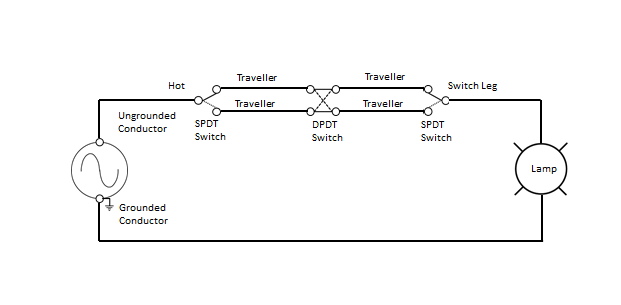38 Three and four-way switching
Aaron Lee
When a light is to be controlled from two different locations, such as the top and bottom of a set of stairs, or a room with more than one entrance, we use a pair of single-pole, double-throw switches to create a 3-way switch loop. If we need to control the light from more than two locations then we simply install a 4-way, or double-pole, double-throw, switch in between the two 3-way switches.
As a rule, we must always install 3-way switches in pairs, and then as many 4-way switches as necessary. For example, if a light is to be controlled from four different locations we would need two 3-way switches and two 4-way switches. If a light was to be controlled from ten different locations, then we would need two 3-way switches and eight 4-way switches.
Each 3-way switch comes with three terminals: one common terminal and two traveller terminals. When installing 3-way switch loops all switching must be done in the ungrounded, or “hot” conductor. The first 3-way switch will have the constant hot connected to its common terminal, then the two traveller terminals will be run to the second 3-way switch, where they will connect to the two traveller terminals. From the final 3-way switch the common terminal is connected to the switch leg which then feeds the lamp load.

When controlling a light from an additional location a double-pole, double-throw, or 4-way switch is inserted in between the two three-way switches

Three and four-way switches are never to be used as disconnection means. If electric loads that are controlled in this manner need to be serviced, power must be safely disconnected at the source. Always observe proper lock-out techniques when working on electrical circuits.
